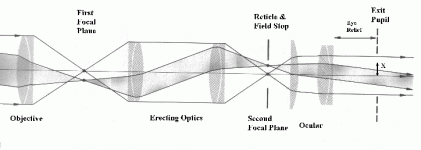Hi Chosun, Thanks for offering up some concrete thoughts. Far more solid than my own! I was conducting a Gedanken experiment to see how far it can go, even fantasizing of a subscription kickstarter project, to hire Kamakura to build an 'edition' of bins to an 'idealized' spec. Or use other means to convince one of the major players to produce a 'retro' custom bin... This is not a practical venture... but interesting.
Meanwhile, you're already thinking specifics..
Standardization. You've addressed an element of it with regard to thinking about prisms, but ahead of that might be agreeing on a format... 7x, 8x, 10x, - 30, 32, 35, 40 42, 50...
Here's a collection of random observations in response:
Prisms:
I was leaning towards Porro, partially because I bow to the experience and expertise around here that I lack. In addition, the simplicity of manufacture might offer an advantage in terms of cost and the opportunity for less things to go wrong...
Plenty of good minds here, but consensus on anything is not a hallmark of this place. I figured on just digging up what I could find on prisms to learn for myself the whats and the whys. There's so many folks who could probably address many issues you bring up straight away, and be done with it.
A few more things to chew on:
You've probably read up on Henry Link's experience with his 8x56 Zeiss Victory FL..achieving a certain optical nirvana by walking between the aberrational raindrops, so to speak...accepting the flaws of manufacture (Zeiss!) and simply reducing the amount by increasing the size of the exit pupil relative to the entrance pupil. A novel approach with a minor drawback: the bins need to be bigger for it to work. Trying to leverage that advantage into another format leaves me thinking: 6x42, 7x50... ?
Moreover, reading a range of comments over the last few months, including Henry's own well done textbook example of an optical evaluation of a binocular for one of the recent Kowa BD xII deluxe turbo something or other...
https://www.birdforum.net/showthread.php?t=384387
Even Henry points out that the wide resolution deficit between the Kowa and his reference standard, the Nikon EII, is probably not noticeable until one puts the binocular on a tripod. Basically, that handheld binoculars can get away with lower resolution, because it can't be detected by most people when used that way..
Listening to Chuck Hill try to tweaze out the optical differences between an Ultravid Silverline and a Noctivid in an entire day out birding, or Canip doing something similar in a Leica shop, comparing the new Trinovid to some others, supports Henry's assertion to some extent, and also tells me that this whole dialogue is exactly what Bill Cook accuses us of doing repeatedly: Stacking BB's and hair splitting, And I think he's right. :t:
Doesn't mean its not fun, but there are a lot of practical realities to chew on...
First off, the current, excellent by most standards, performance of the top roofs is an indisputable benchmark. One can buy an existing product that is THAT GOOD. Drawback: costly.
Also on the market are products like the Habicht and the Canon IS lines, considered top optical performers by many, AND less expensive. Drawback: ergonomic dinosaurs, poor eye relief, narrow FOV on some models.
Then suppose we try to shoehorn Henry's optical strategies into this cauldron of variables...
What is the threshold of decreasing the exit pupil/entrance pupil ratio of performance advantage? I don't have a clue.
Simple example:
I've got a Carton 'Adlerblick' 7x50 binocular that I've owned for over 20 years. Orion sold them, advertised as long eye relief for glasses. Its got a 7° fov, weighs about 785 grams, and close focus is in the 7 meter ballpark. There's an
example of a 50mm Porro that has the weight of a portly 8x42 roof...A viable chassis perhaps to start with?
What if we bump up the specs to 8.25 FOV, close focus 3 meters, maintain eye relief @ 18mm, then how much bigger and heavier would it be? How much more glass does it take to widen, and better correct the field? What if we bump magnification to 8x50?
Would a 6.25 mm exit pupil be enough to grant the improved performance relative to a 7mm EP in daylight viewing? Inquiring minds want to know! (or not!)
Light Transmission: I'll go with a 3% minimum threshold for visual detection, based on some rational consensus on earlier threads I've read. Some of the top roofs are in the 94% range. Even the 7x42 Habicht at reportedly 96% won't likely be a detectable difference, just a numerical advantage on paper. If we aim for a wider field, we're probably adding more glass, which drops the transmission regardless of the prism size...
Attempting to fine tune color balance, flatten the curve, is an interesting endeavor. I have no idea which part of the system would make the most impact on it... maybe coatings.
Cat herding, BB stacking... consensus of format... consensus of anything...
That's all I got for today. I appreciate your interest and energy on the topic.
-Bill








